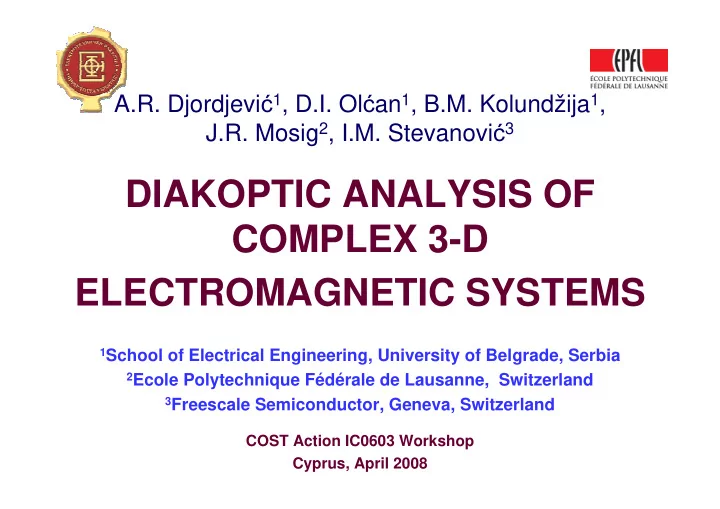

A.R. Djordjevi � 1 , D.I. Ol � an 1 , B.M. Kolundžija 1 , J.R. Mosig 2 , I.M. Stevanovi � 3 DIAKOPTIC ANALYSIS OF COMPLEX 3-D ELECTROMAGNETIC SYSTEMS 1 School of Electrical Engineering, University of Belgrade, Serbia 2 Ecole Polytechnique Fédérale de Lausanne, Switzerland 3 Freescale Semiconductor, Geneva, Switzerland COST Action IC0603 Workshop Cyprus, April 2008
Contents � Present status of research and software development � Plans for future work � Collaboration among universities and STSMs
Diakoptics � Split the original system into smaller nonoverlapping subsystems � Solve each subsystem individually � Combine partial solutions to obtain the solution of the whole system � Diakoptic approach is based on � surface integral-equation (SIE) formulation � equivalence theorem (Huygens’ Principle) � Diakoptic surface integral equation (DSIE) formulation
DSIE efficacy � One outer subsystem (for open systems) and K congruent inner subsystems � The total number of ports for the circuit is KM � Brute-force solution, using tableau system of equations, with total of 2 KM unknowns � More sophisticated solution results in KM unknowns � If topological elimination is used, then the solution time is negligible � Nesting
DSIE efficacy � Assumptions/conditions: � matrix inversion time dominates � K congruent subsystems, each with N unknowns � 2 M unknowns for each diakoptic surface � Total number of unknowns for circuit solution: KM � Efficient when overhead is small ( M << N ) 2 ( ) m KN DSIE � � s � Storage reduction 2 2 m ( ) ( ) � � � N M KM SIE � � =1 for closed systems, � =2 for open systems
DSIE efficacy 3 ( ) t KN DSIE � � Acceleration a 3 3 t ( ) ( ) � � � N M KM SIE
DSIE applications so far � 2-D electrostatic problems with piecewise- homogeneous dielectrics � 3-D electrostatic problems with piecewise- homogeneous dielectrics new results � 2-D quasi-static and dynamic problems (TM,TE) with piecewise-homogeneous media � 3-D dynamic problems with piecewise- homogeneous media NEW
3D electrostatics: 2 cubes � Two metallic cubes 2 Original system z [m] 0 6 -2 4 2 2 0 0 x [m] -2 -2 y [m] Inner subsystems Outer subsystem
3D electrostatics: potential � Potential (verification) Original system Inner subsystems Outer subsystem
3D electrostatics: DSIE performance 6 � Error 5 4 3 � [%] 2 1 0 200 400 600 800 1000 1200 M 6 � Acceleration 5 4 3 a 2 1 0 0 200 400 600 800 1000 1200 M 2.5 � Storage reduction 2.0 1.5 1.0 s 0.5 0.0 0 200 400 600 800 1000 1200 M
3D electrostatics: diakoptic surfaces � Metallic spheres with dielectric coating � Diakoptic surfaces can be arbitrary; they need not touch each other
3D electrostatics: diakoptic surfaces cut the structure � Metallic patches on dielectric substrate � Diakoptic surfaces penetrate into dielectric
3D dynamic: simple scatterer � Metallic plates (scatterers) in dielectric cubes Current distribution Near field 0 1.2 MoM-SIE -2 DSIE 1.0 Real MoM-SIE -4 Imag MoM-SIE -6 0.8 Real DSIE J s [mA/m] -8 Imag DSIE E z [V/m] 0.6 -10 -12 0.4 -14 0.2 -16 -18 0.0 -1.00 -0.75 -0.50 -0.25 0.00 0.25 0.50 0.75 1.00 -20 -15 -10 -5 0 5 10 15 20 25 30 35 40 z - coordinate y [mm]
3D dynamic: simple scatterer � Radar (monostatic) cross section (RCS) 3.25 3.00 MoM-SIE 2.75 DSIE 2.50 2.25 2.00 1.75 2 1.50 � / � 1.25 1.00 0.75 0.50 0.25 0.00 0 40 80 120 160 200 240 280 320 360 � [deg]
3D dynamic: complex scatterer � Metallic cubes (1250) One cluster Outer subsystem One inner subsystem
Complex scatterer: MoM vs. DSIE � RCS � -cut � -cut 15 10 DSIE DSIE 10 MoM-SIE 0 MoM-SIE 5 -10 0 -5 2 [dB] 2 [dB] -20 -10 -30 -15 � / � � / � -20 -40 -25 -50 -30 0 40 80 120 160 200 240 280 320 360 0 30 60 90 120 150 180 � [deg] � [deg] 39 . 7 � 24 557 s 619 s a SIE � DSIE � t t 30 . 5 � 3 . 6 GB 59 MB s SIE � DSIE � m m
3D dynamic: patch antenna array � Patch antennas (cookies) 10 0 g [dB] ( � = 0) -10 -20 -30 -40 Int. Acc. 0 Int. Acc. 2 Int. Acc. 4 Int. Acc. 6 -50 -180 -120 -60 0 60 120 180 � [deg]
3D dynamic: 10 x 10 array � Patch antennas (cookies) � congruent subsystems
Patch arrays: DSIE vs MoM Coefficients Coefficients DSIE Storage reduction Acceleration Array MoM-SIE 3 288 240 13.7 11.8 ��� 7 398 540 43.5 21.4 ��� 13 152 960 68.7 51.1 ��� 20 550 1 500 81.6 107.0 ��� 29 592 2 160 87.5 142.3 ��� 40 278 2 940 90.3 228.1 ��� 52 608 3 840 91.7 349.8 ��� 66 582 4 860 92.5 617.5 ��� 82 200 6 000 93.0 771.9 �����
Future work � Evaluation for arbitrary 3D dynamic problems and comparison with other techniques, STSM (Belgrade, Lausanne, Louvain, Barcelona) � antennas, large arrays � printed circuits, microwave devices � Fully incorporate the diakoptics into existing software based on MoM-SIE (Wipl-D) � subdomain and entire-domain basis functions � Software implementations of DSIE on clusters and parallel-processing computers
Recommend
More recommend